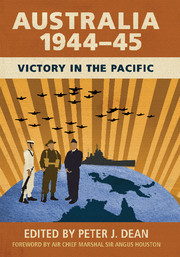Book contents
- Frontmatter
- Dedication
- Foreword
- Contents
- Maps and chart
- Figures and table
- Contributors
- Acknowledgements
- Abbreviations
- Military symbols on maps
- Introduction
- PART 1 STRATEGY
- PART 2 AUSTRALIA AT WAR
- 4 The Long Silence: Australian Prisoners of the Japanese
- 5 Total War on the Australian Home Front, 1943–45
- PART 3 GREEN ARMOUR AND SPECIAL OPERATIONS
- PART 4 THE NAVAL AND AIR WAR
- PART 5 THE NEW GUINEA CAMPAIGN
- PART 6 THE BORNEO CAMPAIGN
- Afterword: And Then Came Peace?
- Index
- References
5 - Total War on the Australian Home Front, 1943–45
from PART 2 - AUSTRALIA AT WAR
Published online by Cambridge University Press: 05 December 2015
- Frontmatter
- Dedication
- Foreword
- Contents
- Maps and chart
- Figures and table
- Contributors
- Acknowledgements
- Abbreviations
- Military symbols on maps
- Introduction
- PART 1 STRATEGY
- PART 2 AUSTRALIA AT WAR
- 4 The Long Silence: Australian Prisoners of the Japanese
- 5 Total War on the Australian Home Front, 1943–45
- PART 3 GREEN ARMOUR AND SPECIAL OPERATIONS
- PART 4 THE NAVAL AND AIR WAR
- PART 5 THE NEW GUINEA CAMPAIGN
- PART 6 THE BORNEO CAMPAIGN
- Afterword: And Then Came Peace?
- Index
- References
Summary
At a press conference on 17 February 1942, two days after the British surrender at Singapore, Prime Minister John Curtin announced that Cabinet had ordered ‘a complete mobilisation of all Australia's resources, human and material’, to meet the Japanese threat. As Curtin explained, the decision put ‘every human being in this country, whether he likes it or not … at the service of the Government to work in the defence of Australia’. Later that day, during a lunch time Liberty Loan drive in Martin Place, Sydney, Curtin spoke of the diversion of the nation's ‘money, machinery, buildings [and] plant’ to the war effort. ‘Nothing you have’, declared the Prime Minister, ‘shall be withheld if the Government says that that is proper for fighting a maximum war’. From the outset, the press referred to this as ‘the Government's plans for total war’.
The legal basis for such an unprecedented extension of economic and social management by the state had been established in September 1939, with the parliament's passing of the National Security Act. This provided the governor-general with authority to issue regulations ‘for securing the public safety and the defence of the Commonwealth’, a power the government wielded with moderation between 1939–41, but used extensively following the Japanese attack on Pearl Harbor. Indeed, between December 1941 and April 1943 the Manual of National Security Regulations index doubled in length, providing the Commonwealth with the means to direct people and their property in support of the war effort. By August 1944 the Manual comprised two volumes, spanning over 1500 pages. Its rules and regulations were administered by various government departments and covered activities as diverse as trading rabbit skins and storing wheat, to rationing, labour dilution, civil defence and measures to control the spread of venereal disease – but all had the purpose of maximising Australia's war effort. Through regulations issued under the National Security Act's authority the Commonwealth came to control where people worked, what they consumed, the information they received and a myriad of other things that Australians took for granted before the war. ‘In effect’, as David Lee puts it, ‘the whole productive system of the nation was placed under government control and direction and many of the incentives for individuals operating in a market system were suspended’. Never before or since has the Australian government had such control over the everyday movements and activities of white Australians.
- Type
- Chapter
- Information
- Australia 1944–45Victory in the Pacific, pp. 98 - 118Publisher: Cambridge University PressPrint publication year: 2015
References
- 1
- Cited by



